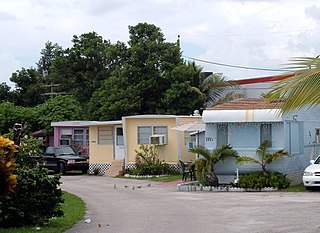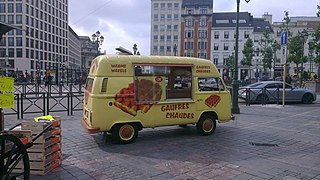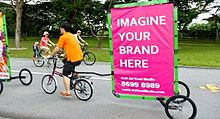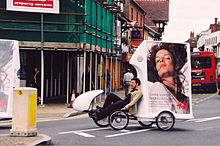Adware, often called advertising-supported software by its developers, is software that generates revenue for its developer by automatically generating online advertisements in the user interface of the software or on a screen presented to the user during the installation process. The software may generate two types of revenue: one is for the display of the advertisement and another on a "pay-per-click" basis, if the user clicks on the advertisement. Some advertisements also act as spyware, collecting and reporting data about the user, to be sold or used for targeted advertising or user profiling. The software may implement advertisements in a variety of ways, including a static box display, a banner display, a full screen, a video, a pop-up ad or in some other form. All forms of advertising carry health, ethical, privacy and security risks for users.

Advertising is the practice and techniques employed to bring attention to a product or service. Advertising aims to put a product or service in the spotlight in hopes of drawing it attention from consumers. It is typically used to promote a specific good or service, but there are wide range of uses, the most common being the commercial advertisement.

A bus is a road vehicle that carries significantly more passengers than an average car or van, but less than the average rail transport. It is most commonly used in public transport, but is also in use for charter purposes, or through private ownership. Although the average bus carries between 30 and 100 passengers, some buses have a capacity of up to 300 passengers. The most common type is the single-deck rigid bus, with double-decker and articulated buses carrying larger loads, and midibuses and minibuses carrying smaller loads. Coaches are used for longer-distance services. Many types of buses, such as city transit buses and inter-city coaches, charge a fare. Other types, such as elementary or secondary school buses or shuttle buses within a post-secondary education campus, are free. In many jurisdictions, bus drivers require a special large vehicle licence above and beyond a regular driving licence.

A trailer park, caravan park, mobile home park, mobile home community or manufactured home community is a temporary or permanent area for mobile homes and travel trailers. Advantages include low cost compared to other housing, and quick and easy moving to a new area.

A billboard is a large outdoor advertising structure, typically found in high-traffic areas such as alongside busy roads. Billboards present large advertisements to passing pedestrians and drivers. Typically brands use billboards to build their brands or to push for their new products.
Advertising in video games is the integration of advertising into video games to promote products, organizations, or viewpoints.

A mobile home is a prefabricated structure, built in a factory on a permanently attached chassis before being transported to site. Used as permanent homes, or for holiday or temporary accommodation, they are often left permanently or semi-permanently in one place, but can be moved, and may be required to move from time to time for legal reasons.

In bus advertising, buses and their related infrastructure is a medium commonly used by advertisers to reach the public with their message. Usually, this takes the form of promoting commercial brands, but can also be used for public campaign messages. Buses may also be used as part of a political or promotional campaign, or as a tool in a commercial enterprise.
Out-of-home (OOH) advertising, also called outdoor advertising, outdoor media, and out-of-home media, is advertising experienced outside of the home. This includes billboards, wallscapes, and posters seen while "on the go". It also includes place-based media seen in places such as convenience stores, medical centers, salons, and other brick-and-mortar venues. OOH advertising formats fall into four main categories: billboards, street furniture, transit, and alternative.
Online advertising, also known as online marketing, Internet advertising, digital advertising or web advertising, is a form of marketing and advertising that uses the Internet to promote products and services to audiences and platform users. Online advertising includes email marketing, search engine marketing (SEM), social media marketing, many types of display advertising, and mobile advertising. Advertisements are increasingly being delivered via automated software systems operating across multiple websites, media services and platforms, known as programmatic advertising.

A sandwich board is a type of advertisement tool composed of two boards with a message or graphic on it and being either carried by a person, with one board in front and one behind in a triangle shape, hinged along the top, creating a "sandwich" effect; or set up next to a store advertising its goods. In this way, the advertising message can be read on both sides interchangeably.

Digital signage is a segment of electronic signage. Digital displays use technologies such as LCD, LED, projection and e-paper to display digital images, video, web pages, weather data, restaurant menus, or text. They can be found in public spaces, transportation systems, museums, stadiums, retail stores, hotels, restaurants and corporate buildings etc., to provide wayfinding, exhibitions, marketing and outdoor advertising. They are used as a network of electronic displays that are centrally managed and individually addressable for the display of text, animated or video messages for advertising, information, entertainment and merchandising to targeted audiences.

Mobile catering is the business of selling prepared food from some sort of vehicle. It is a feature of urban culture in many countries. Mobile catering can be performed using food trucks, trailers, carts and food stands with many types of foods that can be prepared. Mobile catering is also used to provide food to people during times of emergency.

A human billboard is someone who applies an advertisement on their person. Most commonly, this means holding or wearing a sign of some sort, but also may include wearing advertising as clothing or in extreme cases, having advertising tattooed on the body. Sign holders are known as human directionals in the advertising industry, or colloquially as sign walkers, sign wavers, sign spinners, sign twirlers or sandwich men. Frequently, they will spin or dance or wear costumes with the promotional sign in order to attract attention.
The term fleet media refers to the placement of advertisements on the side of trucks, vans, and other forms of transportation that form part of a commercial fleet. It entails more than the addition of a company logo, name and number to the vehicles belonging to that company. The crucial difference is that fleet media, like any other form of advertising, is commercially available. If it is possible to buy space on a retailer’s delivery fleet then this would be fleet media as a form of retail media. Equally if a delivery/logistics company were to sell advertising space on its delivery vans this would be fleet media. </ref>

A field kitchen is a kitchen used primarily by militaries to provide hot food to troops near the front line or in temporary encampments. Designed to be easily and quickly moved, they are usually mobile kitchens or mobile canteens, though static and tent-based field kitchens exist and are widely used.

A truckside advertisement or truckside ad is a billboard that is affixed to a truck that is for the purpose of advertising to the general public. This is a form of outdoor advertising classified as transit advertising by the outdoor advertising association of America.

Aerial advertising is a form of advertising that incorporates the use of flogos, manned aircraft, or drones to create, transport, or display, advertising media. The media can be static, such as a banner, logo, lighted sign or sponsorship branding. It can also be dynamic, such as animated lighted signage, skywriting, or audio.
Brandalism is an activist artist collective founded in 2012 in the United Kingdom which engages in subvertising, culture jamming, and protest art. Brandalism uses subvertising to alter and critique corporate advertising by creating parodies or spoofs to replace ads in public areas. The art is typically intended to draw attention to political and social issues such as consumerism and the environment. Advertisements produced by the Brandalism movement are silk screen printed artworks, and may take the form of a new image, or a satirical alteration to an existing image, icon or logo. The advertisements are often pasted over billboards, or propped under the glass of roadside advertising spaces.

A vehicle vinyl wrap is the automotive aftermarket practice of completely or partially covering a vehicle's original paint with a vinyl wrap. Generally this vinyl wrap will be a different color or finish like a gloss, matte or clear protective layer.

















